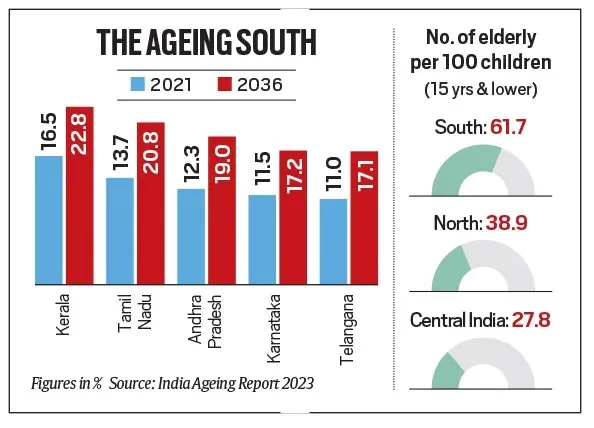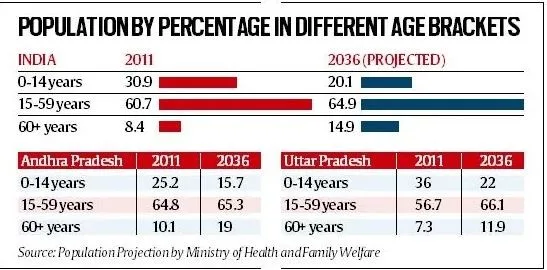Syllabus: GS1/ Social Issue, Population
Context
- Andhra Pradesh Chief Minister pointed to a declining fertility rate in southern states, which has dropped to 1.6—well below the national average of 2.1.
Trends in Southern India Population
- Declining Fertility Rates: Southern Indian states like Andhra Pradesh, Tamil Nadu, and Kerala have already reached or are nearing replacement-level fertility (2.1 children per woman). For instance:

- Andhra Pradesh achieved this in 2004.
- Kerala reached this level as early as 1988.
- These states have significantly lower fertility rates compared to Northern India, contributing to slower population growth.
- Aging Population: With lower fertility rates and increasing life expectancy, the population in Southern India is aging rapidly:
- Kerala’s 60+ population is projected to rise from 13% in 2011 to 23% by 2036.
- Andhra Pradesh and Tamil Nadu are also witnessing a similar demographic shift, creating a growing proportion of elderly residents.
- Population Growth Contribution: Southern states are projected to contribute only 9% to India’s total population growth from 2011 to 2036. In contrast, Northern states like Uttar Pradesh and Bihar will account for a much larger share of India’s future population growth.
- Internal Migration and Workforce: Due to declining birth rates and a shrinking working-age population, Southern states are becoming more reliant on migrants from Northern India to fill labor shortages and maintain economic growth.
- Impact on Political Representation: Slower population growth in Southern India raises concerns about political representation. After the delimitation of constituencies, Southern states might lose some parliamentary seats, while more populous Northern states like Uttar Pradesh and Bihar may gain representation.
- Economic and Healthcare Strain: The growing elderly population in Southern states is expected to increase healthcare expenditures and place further demands on social security systems.

Challenges With Population Decline
- Economic Impact: A high percentage of the aging population does imply that the state may have to spend more on taking care of this growing population.
- There is an increased pressure on pension systems and social security.
- Need of Caregiving: With a rise in the elderly population, there is a growing need for caregivers.
- Families can struggle to balance caregiving responsibilities with work and personal lives.
- Social Isolation: Older adults often face social isolation, especially in urban areas where traditional family structures are changing.
- Impact on women: Poverty is inherently gendered in old age when older women are more likely to be widowed, living alone, with no income and with fewer assets of their own, and fully dependent on family for support.
- Policy Development: There is a need for comprehensive policies addressing the needs of older adults, including healthcare, housing, and social welfare.
- North-South Divide: Northern states like Uttar Pradesh, which contribute more to India’s population, may see increased political and economic focus, affecting resource distribution.
Way Ahead
- Promoting Internal Migration: Southern states can alleviate workforce shortages by drawing in workers from Northern India, which has a larger working-age population. This can help bridge the gap created by a declining young population in the South.
- Workforce Development: Investments in automation, advanced technology, and skills retraining programs will be key to efficiently managing a shrinking labor force. This approach can maintain productivity while mitigating the effects of fewer young workers.
- Incentivize families: Focus on healthcare, education, and employment opportunities—could be more effective in encouraging higher birth rates.
- Balanced Growth: To minimize regional disparities, equal emphasis on economic and social development across both Northern and Southern states is crucial. This can ensure sustainable internal migration and reduce socio-economic imbalances across regions.
Source: IE
Previous article
News In Short 21-10-2024
Next article
Rural Youth Lead India’s Digital Transformation